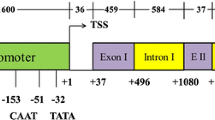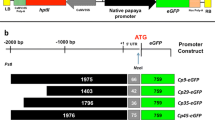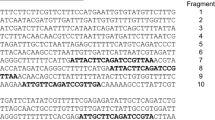Abstract
The maize polyubiquitin-1(Ubi-1) promoter is one of a few select promoters used to express foreign genes in monocots, such that recombinant proteins can be produced at commercially viable levels. Modifying the activity, specificity and responsiveness of such promoters provides a means to achieve desired levels and patterns of expression of genes encoding target products. Ubi-1 is constitutively expressed but is further induced by heat shock. The promoter contains two overlapping sequences with similarity to defined heat shock elements and we show that these sequences are also present upstream of the Ubi-1 homologue isolated from teosinte. Both the maize and teosinte promoters can mediate a heat shock response in transgenic maize. We have dissected the overlapping maize Ubi-1 promoter heat shock elements and demonstrate that the 3′ element is required to mediate a heat shock response. The Ubi-1 promoter is particularly active in tissues consisting of rapidly dividing cells, and within the seed it is strongly biased towards driving expression in the embryo. However, replacement of the heat shock elements with a trimer of a basic domain/leucine zipper factor binding site of a pea lectin promoter shifts the balance in seed expression towards the endosperm. The Ubi-1 variants described here differ in their overall activity in the seed, but they all show potential for driving high levels of heterologous gene expression in maize.
Similar content being viewed by others
References
Bradford MM (1976) A rapid and sensitive method for the quantitation of microgram quantities of protein utilizing the principle of protein-dye binding. Anal Biochem 172: 248–254.
Chatterjee M, Sparvoli S, Edmunds C, Garosi P, Findlay K and Martin C (1996) DAG, a gene required for chloroplast differentiation and palisade development in Antirrhinum majus. EMBO J 15: 4194–4207.
Cho MJ, Wong JH, Marx C, Jiang W, Lemaux PG and Buchanan BB (1999) Overexpression of thioredoxin leads to enhanced activity of starch debranching enzyme (pullulanase) in barley grain. Proc Natl Acad Sci USA 96: 14641–14646.
Cho MJ, Choi HW, Jiang W, Ha CD and Lemaux PG (2002a) Endosperm-specific expression of green fluorescent protein driven by the hordein promoter is stably inherited in transgenic barley (Hordeum vulgare) plants. Physiol Plant 115: 144–154.
Cho Y, Fernandes J, Kim SH and Walbot V (2002b) Gene-expression profile comparisons distinguish seven organs of maize. Genome Biol 29: research0045.
Christensen AH, Sharrock RA and Quail PH (1992) Maize polyubiquitin genes: structure, thermal perturbation of expression and transcript splicing, and promoter activity following transfer to protoplasts by electroporation. Plant Mol Biol 18: 675–689.
Christensen AH and Quail PH (1996) Ubiquitin promoter-based vectors for high-level expression of selectable and/or screenable marker genes in monocotyledonous plants. Transgenic Res 5: 213–218.
Comai L, Moran P and Maslyar D (1990) Novel and useful properties of a chimeric plant promoter combining CaMV 35S and MAS elements. Plant Mol Biol 15: 373–381.
Cornejo MJ, Luth D, Blankenship KM, Anderson OD and Blechl AE (1993) Activity of a maize ubiquitin promoter in transgenic rice. Plant Mol Biol 23: 567–581.
de Pater S, Katagiri F, Kijne J and Chua N-H (1994) bZIP proteins bind to a palindromic sequence without an ACGT core located in a seed-specific element of the pea lectin promoter. Plant J 6: 133–140.
de Pater S, Pham K, Chua N-H, Memelink J and Kijne J (1993) A 22-bp fragment of the pea lectin promoter containing essential TGAC-like motifs confers seed-specific gene expression. Plant Cell 5: 877–886.
de Pater S, Pham K, Klitsie I and Kijne J (1996) The 22 bp W1 element in the pea lectin promoter is necessary and, as a multimer, sufficient for high gene expression in tobacco seeds. Plant Mol Biol 32: 515–523.
Diaz I, Vincente-Carbajosa J, Abraham Z, Martinez M, Isabel-La Modeda I and Carbonero P (2002) The GAMYB protein from barley interacts with the DOF transcription factor BPBF and activates endosperm-specific genes during seed development. Plant J 29: 453–464.
Guilley H, Dudley RK, Jonard G, Balazs E and Richards KE (1982) Transcription of Cauliflower mosaic virus DNA: Detection of promoter sequences, and characterization of transcripts. Cell 30: 763–773.
Hood EE, Witcher DR, Maddock S, Meyer T, Baszczynski C, Bailey M et al. (1997) Commercial production of avidin from transgenic maize: Characterization of transformant, production, processing, extraction and purification. Mol Breed 3: 291–306.
Horvath H, Huang J, Wong O, Kohl E, Okita T, Kannangara CG et al. (2000) The production of recombinant proteins in transgenic barley grains. Proc Natl Acad Sci USA 97: 1914–1919.
Ishida Y, Saito H, Ohta S, Hiei Y, Komari T and Kumashiro T (1996) High efficiency transformation of maize (Zea mays L.) mediated by Agrobacterium tumefaciens. Nat Biotechnol 14: 745–750.
Jefferson RA, Kavanagh TA and Bevan MW (1987) GUS fusions: Beta-glucuronidase as a sensitive and versatile gene fusion marker in higher plants. EMBO J 6: 3901–3907.
Kusnadi AR, Hood EE, Witcher DR, Howard JA and Nikolov ZL (1998) Production and purification of two recombinant proteins from transgenic corn. Biotechnol Prog 14: 149–155.
Lamacchia C, Shewry PR, Di Fonzo N, Forsyth JL, Harris N, Lazzeri PA et al. (2001) Endosperm-specific activity of a storage protein gene promoter in transgenic wheat seed. J Exp Bot 52: 243–250.
Lee JM, Williams ME, Tingey SV and Rafalski JA (2002) DNA array profiling of gene expression changes during maize embryo development. Funct Integr Genomics 2: 13–27.
Leung J, Fukuda H, Wing D, Schell J and Masterson R (1991) Functional analysis of cis-elements, auxin response and early developmental profiles of the mannopine synthase bi-directional promoter. Mol Gen Genet 230: 463–474.
Liu L, Maillet DS, Roger J, Frappier H, Walden DB and Atkinson BG (1995) Characterization, chromosomal mapping, and expression of different polyubiquitin genes in tissues from control and heat-shocked maize seedlings. Biochem Cell Biol 73: 19–30.
Ouwerkerk PB, de Kam RJ, Hoge JH and Meijer AH (2001) Glucocorticoid-inducible gene expression in rice. Planta 213: 370–378.
Padidam M (2003) Chemically regulated gene expression in plants. Curr Opin Plant Biol 6: 169–177.
Pelham HR (1982) A regulatory upstream promoter element in the Drosophila hsp 70 heat-shock gene. Cell 30: 517–528.
Pelham HR and Bienz M (1982) A synthetic heat-shock promoter element confers heat-inducibility on the herpes simplex virus thymidine kinase gene. EMBO J 1: 1473–1477.
Rance I, Norre F, Gruber V and Theisen M (2002) Combination of viral promoter sequences to generate highly active promoters for heterologous therapeutic protein over-expression in plants. Plant Sci 162: 833–842.
Roussell DL, Boston RS, Goldsborough PB and Larkins BA (1988) Deletion of DNA sequences flanking an Mr 19,000 zein gene reduces its transcriptional activity in heterozygous plant tissues. Mol Gen Genet 211: 202–209.
Russell DA and Fromm ME (1997) Tissue-specific expression in transgenic maize of four endosperm promoters from maize and rice. Transgenic Res 6: 157–168.
Sanger M, Daubert S and Goodman RM (1990) Characteristics of a strong promoter from figwort mosaic virus: Comparison with the analogous 35S promoter from cauliflower mosaic virus and the regulated mannopine synthase promoter. Plant Mol Biol 14: 433–443.
Schmidt RJ, Ketudat M, Aukerman MJ and Hoschek G (1992) Opaque-2 is a transcriptional activator that recognizes a specific target site in 22-kDa zein genes. Plant Cell 4: 689–700.
Stacey J and Issac PG (1994) Isolation of DNA from plants. Methods Mol Biol 28: 9–15.
Takimoto I, Christensen AH, Quail PH, Uchimiya H and Toki S (1994) Non-systemic expression of a stress-responsive maize polyubiquitin gene (Ubi-1) in transgenic rice plants. Plant Mol Biol 26: 1007–1012.
Takaiwa F, Yamanouchi U, Yoshihara T, Washida H, Tanabe F, Kato A et al. (1996) Characterization of common cisregulatory elements responsible for the endosperm-specific expression of members of the rice glutelin multigene family. Plant Mol Biol 30: 1207–1221.
Trick HN and Finer JJ (1997) SAAT: Sonication assisted Agrobacterium-mediated transformation. Transgenic Res 6: 329–336.
Vincente-Carbajosa J, Moose SP, Parsons RL and Schmidt RJ (1997) A maize zinc-finger protein binds the prolamin box in zein gene promoters and interacts with the basic leucine zipper transcriptional activator Opaque 2. Proc Natl Acad Sci USA 94: 7685–7690.
Wang J, Jiang J and Oard JH (2000) Structure, expression and promoter activity of two polyubiquitin genes from rice (Oryza sativa L.). Plant Sci 156: 201–211.
Washida H, Wu CY, Suzuki A, Yamanouchi U, Akihama T, Harada K et al. (1999) Identification of cis-regulatory elements required for endosperm expression of the rice storage protein glutelin gene GluB-1. Plant Mol Biol 40: 1–12.
Wilson KA (1997) The protease inhibitors of seeds. In: Larkins BA and Vasil IK (eds), Cellular and Molecular Biology of Plant Seed Development. (pp. 331–374) Kluwer Academic Publishers, Dordrecht/Boston/London.
Witcher DR, Hood EE, Peterson D, Bailey M, Bond D, Kusnadi A, et al. (1998) Commercial production of β-glucuronidase (GUS): A model system for the production of proteins in plants. Mol Breed 4: 301–312.
Woo YM, Hu DW, Larkins BA and Jung R (2001) Genomics analysis of genes expressed in maize endosperm identifies novel seed proteins and clarifies patterns of zein gene expression. Plant Cell 13: 2297–2317.
Woodard SL, Mayor JM, Bailey MR, Barker DK, Love RT, Lane JR, et al. (2003) Maize-derived bovine trypsin: characterization of the first large-scale, commercial protein product from transgenic plants. Biotechnol Appl Biochem 38: 123–130.
Yang D, Guo F, Liu B, Huang N and Watkins SC (2003) Expression and localization of human lysozyme in the endosperm of transgenic rice. Planta 216: 597–603.
Yang SH, Moran DL, Jia HW, Bicar EH, Lee M and Scott MP (2002) Expression of a synthetic porcine alphalactalbumin gene in the kernels of transgenic maize. Transgenic Res 11: 11–20.
Yang D, Wu L, Hwang YS, Chen L and Huang N (2001) Expression of the REB transcriptional activator in rice grains improves the yield of recombinant proteins whose genes are controlled by a Reb-responsive promoter. Proc Natl Acad Sci USA 98: 11438–11443.
Zhong G-Y, Peterson D, Delaney DE, Bailey M, Witcher DR, Register JC(III), et al. (1999) Commercial production of aprotinin in transgenic maize seeds. Mol Breed 5: 345–356.
Zuo J and Chua N-H (2000) Chemical-inducible systems for regulated expression of plant genes. Curr Opin Biotechnol 11: 146–151.
Author information
Authors and Affiliations
Corresponding author
Rights and permissions
About this article
Cite this article
Streatfield, S.J., Magallanes-Lundback, M.E., Beifuss, K.K. et al. Analysis of the Maize Polyubiquitin-1 Promoter Heat Shock Elements and Generation of Promoter Variants with Modified Expression Characteristics. Transgenic Res 13, 299–312 (2004). https://doi.org/10.1023/B:TRAG.0000040053.23687.9c
Issue Date:
DOI: https://doi.org/10.1023/B:TRAG.0000040053.23687.9c




